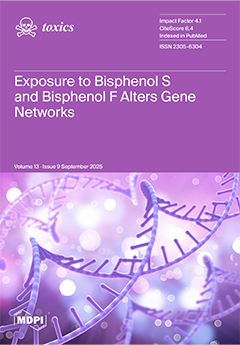Urban industrialization is a major driver of water pollution, particularly through emerging contaminants that pose significant health risks for humans and ecosystems. This critical review focuses on Bangladesh’s Buriganga and Dhaleshwari rivers, which pass through highly industrialized and urban areas, analyzing contaminant types,
[...] Read more.
Urban industrialization is a major driver of water pollution, particularly through emerging contaminants that pose significant health risks for humans and ecosystems. This critical review focuses on Bangladesh’s Buriganga and Dhaleshwari rivers, which pass through highly industrialized and urban areas, analyzing contaminant types, sources, pathways, and impacts. By synthesizing data from studies published between 2005 and 2024, the paper examines pollutants such as heavy metals (e.g., Cr, Cd, Pb, Ni, Zn, Hg, As, Mn, Cu, Fe) and microplastics in water, sediments, and biota. The Buriganga River shows extreme heavy metal contamination, with surface water Cr concentrations reaching up to 167,160 μg/L, Pb up to 3830 μg/L, and Fe up to 30,000 μg/L, and sediment Cr up to 4249 μg/g, Pb up to 3312 μg/g, and Fe up to 15,435 μg/g. In contrast, the Dhaleshwari River exhibits elevated but comparatively lower heavy metal concentrations in surface water (e.g., Cr up to 3350 μg/L; Cd up to 1890 μg/L; Pb up to 1320 μg/L; Ni up to 1732 μg/L; Fe up to 6040 μg/L) and sediments (Cr up to 282 μg/g; Fe up to 14,375 μg/g). Microplastic contamination in Buriganga is widespread across water, sediments, and biota and dominated by polymers such as polyethylene (PE), polypropylene (PP), and polyethylene terephthalate (PET). Industrial discharges, particularly from the textile, leather, and metal processing industries, are identified as primary sources for heavy metals and microplastics. Additional inputs from domestic waste, agricultural runoff, and municipal sewage intensify pollution, with Cr, Cd, and Pb notably frequently exceeding safety thresholds. Microplastics, originating from municipal waste and atmospheric deposition, persist in these rivers, posing ecological and public health risks. The persistence and bioaccumulation of heavy metals and microplastics threaten aquatic biodiversity by disrupting food chains and pose significant risks to local communities that depend on these rivers for agriculture, fishing, and daily water use. This review highlights the urgent need for comprehensive bioaccumulation studies, long-term monitoring, and enhanced detection techniques to better assess contamination levels. Strengthening environmental regulations, improving waste management, and adopting sustainable industrial practices are critical to mitigating emerging contaminant impacts and safeguarding these vital river ecosystems and public health.
Full article






